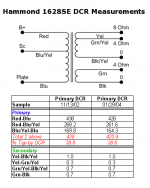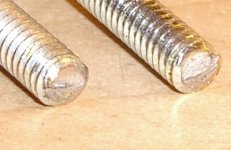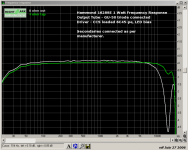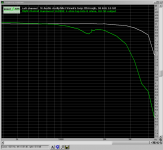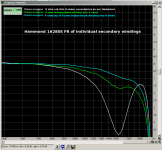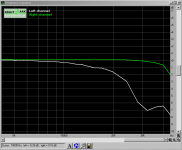tubelab.com said:Well the secondaries look normal, but the primary does NOT. After a little head scratching, I came to the realization that the blue and the blue - yellow wires are SWITCHED!
Thanks tubelab. The mystery deepens. Your results spurred me to finally pry the Hammonds from the chassis and re-measure them. To first rectify earlier misinformation I propagated, the secondaries of my 1628SE OPTs measure in the sequence shown in Hammond's wiring documentation. The DCR between windings however don't correspond with the labels. The earlier repeated measurements I can only blame on over/under medicating or low batteries in the Fluke 87. The secondaries are split.
However my primaries appear to have been wired properly and the dreaded 13 kHz null appeared in multiple EL84 circuits (pentode and triode.) The full set of DCR measurements is shown below. The numbers in red are sanity-check calcs. Did your response tests use the 8-ohm taps wired as per Hammond's directions?
Attachments
Yes the transformers were wired according to Hammonds diagram. I have spent most of today testing these transformers in UL and triode mode, with cathode feedback and without. I will graph the results and put it on the website in the near future. At power levels below 10 watts, the distortion at 44 Hz is nearly the same as 1KHz. These are the only transformers that I have that pass this test.
I tested the frequency response for 4 -ohm of the 1628SE OPT. It appears almost flat from 10 to 20kHz.
Johnny
Johnny
My 1627SEA arrived today. (radiodaze.com) But my amp is not done yet and I don't have instruments to test it.
kmtang said:I tested the frequency response for 4 -ohm of the 1628SE OPT. It appears almost flat from 10 to 20kHz.
I'll try just that, drive the 5K tap with a triode-connected 813 and use the 4 ohm taps. I might yet salvage these beasts.
I tested the frequency response for 4 -ohm of the 1628SE OPT. It appears almost flat from 10 to 20kHz.
I guess that there are many versions of this transformer, or maybe each batch is different, I don't know. I posted the measured response (in UL mode) of my transformers (both are now the same) back in post number 39. I retested them wired for 4 ohms, I got the same result. The rolloff (-3.2 db at 20 KHz) is not quite as severe when wired for 16 ohms (-2.8 db at 20 KHz).
I also ran these transformers in triode mode (same response). I then tried them with cathode feedback this improved the high end by over a db in UL or triode mode. I took a lot of power VS distortion measurements. These things will run at full power (12 watt amp) down to 25 Hz without distorting! The big Edcors will not. I will be doing simplar testing on the Edcors this weekend. All data will be on the web site when I am finished.
I have been listening to the 1628SE's powered by some $4 6L6GC's cranked to well beyond their dissipation ratings, and I do like the sound. The bass is amazing. They bring sounds out of my 7 inch speakers that don't usually come out. I am going to drag this amp out into the living room this weekend to see what it does to the 15 inch speakers! The dynamics and transients are also great. If the 1628SEA's solve the HF problems Hammond will have a winner.
I sure don't know what all this business of dissing Hammonds is all about. For my 807 amp project, I have the Hammond 1650G 35W 6K6 : 8R output xfmrs, and these performed as promised: f(l)= 30Hz; f(h)= 29KHz and that with no NFB connected. I sure didn't see any dips at any audio frequency. Adding both an inner feedback loop and gNFB, the resulting performance was a measured f(l)= 7.0Hz; f(h)= 35KHz (-3.0db(v)). As for how they sound: just great. Bass packs plenty of authority with clarity and detail to the mids and highs. Again, I have had zero problems either with instability under gNFB, or frequency peaks and nulls.
As for the Hammond 275-0-275 power xfmr, again, no problems even though it's being pushed a bit harder than its 200mA rating. It doesn't heat up excessively, and has been going strong for several hours a day for going on seven months now. Of course, the 5.0V secondary isn't being used at all, and the 6.3V secondary is connected to one panel LED. As for peeling paint, missing insulation washers, dyked-off screws, I see nothing like that at all. In all three Hammonds, it looks like all the lams were installed correctly without gapping or nonuniform placement. So far as finish is concerned, it's better than the NOS StanCor power xfmr I also have, which has gobs of dried varnish along one end that'll need to be removed to improve the appearance.
The Hammonds delivered as promised, and I have no complaints whatsoever.
As for the Hammond 275-0-275 power xfmr, again, no problems even though it's being pushed a bit harder than its 200mA rating. It doesn't heat up excessively, and has been going strong for several hours a day for going on seven months now. Of course, the 5.0V secondary isn't being used at all, and the 6.3V secondary is connected to one panel LED. As for peeling paint, missing insulation washers, dyked-off screws, I see nothing like that at all. In all three Hammonds, it looks like all the lams were installed correctly without gapping or nonuniform placement. So far as finish is concerned, it's better than the NOS StanCor power xfmr I also have, which has gobs of dried varnish along one end that'll need to be removed to improve the appearance.
The Hammonds delivered as promised, and I have no complaints whatsoever.
Miles Prower said:As for peeling paint, missing insulation washers, dyked-off screws...
Don't know, lucky? Mine have been stripped and repainted because of the poor finish (not a task I enjoyed though they look great now) but I kept the screws:
Attachments
The 5K James was pulled from a GU-50 circuit on the bench and the Hammond 1628SE substituted. In the frequency response plots shown below the 8 ohm run was set at 1 watt into an 8 ohm resistor. For the 4 ohm plot only the ouput tap was changed and a 1000 ohm pot adjusted (it was in circuit for both runs) to match the 8 ohm level into the soundcard.
Attachments
I just got a Hammond 270FX power transformer for a project of mine. Yes, the two screws at the bottom of the transformer are cut off so that there's no interference with anything going through the mounting slots. The paint job is adequate. For a $40 domestically made transformer, it's ok, though I've yet to power it up and see where the filament voltages are centered. As has been mentioned before, it's on par or better looking than a lot of my nos/ used vintage iron. I got it along with a pair of 125CSE transformers. They aren't fashion plates, either, but the price was right for their intended purpose, whuich was a quick attempt to see if I can wring 2W out of the big triode section of a 6GF7 in SE stylee...
Well it gets more interesting still. The secondary windings were split and measured independently. The results are once again below. The 20 kHz limit is mostly soundcard. A level mismatch above 10 kHz appears between the two 4 ohm windings. The independent 4 ohm also has a bit of a null and most likely significant phase shift. Tying the two together as designed results in partial cancellation above 10 kHz. The bright side is there appeared to be little-to-no level difference into an 8 ohm load between using one 4 ohm winding and parallelling them. An approach might be to use the independent 4 ohm winding for output tube cathode feedback instead.
That's an experiment for another night and a tube which requires less drive than a GU-50.
See post #55 below for correct graph (by request from rdf -anatech)
That's an experiment for another night and a tube which requires less drive than a GU-50.
See post #55 below for correct graph (by request from rdf -anatech)
In the frequency response plots shown below....
Ouch that IS nasty. Mine was not that bad even when it was wired wrong. I did some digging around on the web and it seems that the problem has to do with a phase imbalance between the 2 secondary windings. They try (successfully in your case) to cancel each other when they are wired in parallel. Try using just one secondary. leave the one that only has two wires open, you will get more loss, but the frequency response may not be as bad. Others have reported good luck running them in 16 ohm configuration. Use with an 8 ohm speaker results in a 2500 ohm transformer. Others have decided to use them as plate chokes for parafeed amplifiers (all secondaries open).
I sure don't know what all this business of dissing Hammonds is all about.
I have used several Types of Hammond transformers over the years. They have always done the job they were intended to do. I routinely use Allied power transformers (made by Hammond) which are rated more conservatively than a similar sized Hammond. I routinely run them at (or over) their ratings without issue.
An SE output transformer is a lot harder to get right than a P-P output or a power transformer. The 1628's that I ordered were the first SE's that I got from Hammond. After my initial discovery of poor performance, I found all of the bad press about this particular model. I later discovered that only one of the transformers performed poorly, and that it was miswired. This may have been an isolated unusual case, but it is odd. The fit and finnish of these transformers is OK. The paint on the bells is good, but the laminations are unevenly covered with transformer varnish.
Now that I have figured out the wiring (the blue - yellow wire is connected to the plate on one transformer) the two units test identical and sound pretty good. They still do not meet the published specs though. I have a pair of 1628SEA's on order and I will objectively test them when they arrive.
In the world of low volume manufacturing it takes only one bad batch of parts to alienate your customer base. Add a dose of bad or unresponsive customer service and you get dissed all over the internet. I read that some people actually got their transformers replaced by Hammond, and the distributor had issued an RMA for mine, but I have decided to keep them.
I had bought a bad set of 300B's about 4 years ago. Then I bought a second set that were bad. A few calls and e-mails to the distributors customer service resulted in a tough s*** return e-mail. I still avoid their tubes even though many people swear by them.
tubelab.com said:Ouch that IS nasty.
And not helped by the fact I mislabeled the white curve in the preceeding graph. That's the response from the 8 ohm tap, not the 4 ohm. I'll post a correction tonight from home and plead with the mods to delete that one. The correct 4 ohm vs. 8 ohm response is in the graph before that. Not too bad at all, just a ~ 0.5 dB dip around 18 kHz. The rolloff above is almost certainly soundcard. Completely liveable.
I'm not 100% convinced though that the 4 ohm phase imbalance explains everything. The 4 ohm response alone doesn't display a deep null. It's not until the remainder of the 8 ohm winding is tacked on top that things go south. It's appears instead some weird complex reaction between the phase imbalance you describe and that remaining section winding.
So I have at least a couple options (including splitting the secondaries and using one for cathode feedback) for turning these trannies around. And the 813 might just be the tube to provide the required power overhead. Also have a box of 828's if that's overkill. Given your accolades regarding the bass I can't wait to hear what they'll do running an effective 10K:8 driven with a big transmitter tube. 🙂
The rolloff above is almost certainly soundcard.
Hook the soundcard inputs directly to its output and run a curve. That way you will know what it does. Mine runs flat up to 21 KHz and then drops sharply in 44 KHz mode. I use it in 96 KHz mode which is flat to 46 KHz. The rolloff looks a lot like what I get from my transformers, only we are using different scales.
Test the 16 ohm outputs, if they are useable you could do a PSE amplifier using any of the popular audio tubes. Way simpler than the 813. But then the 813 would be way cooler, just harder to build. 828's, I have some of those too, haven't tried them yet.
The M-Audio Win 2K drivers are a bear and tend to tank RightMark if changes in sampling frequency aren't handled carefully. More than 44.1 at 24-bit is an issue too so as most of my runs are for distortion I tend to stick with 44.1 at 24-bit. However it will do 96 kHz and the 1628SE test results below are a bit of a shock. White trace = soundcard loop-through, green = Hammond 1628SE 4-ohm tap into 8-ohm resistor.
Attachments
And if it's possible mods, can the graphic file in Post # 51 be blown out with a note to 'see Post #55 below'?
I've haven't tried many of the more common output tubes in SE, well really just the KT100 representing the entire 6L6 family. I wasn't impressed. That said I tune B+ and bias to minimize upper harmonics and pretty much ignore the 2nd. The GU-50 was much cleaner in that regard.
As I understand it, the 828 is 70% of the 813. Vg2 is still good for 750 VDC and the pentode curves at that screen voltage look much better than those for its highly regarded big brother. I don't need much power (Tannoy 12" Golds) so I'm thinking the combination of excellent linearity, easy drive (2 stage amp with a 6C45 CCS), a 10K effective primary and the choice of 2 transmiting tubes should provide an excellent opportunity to make a decent DF, relatively low distortion SE in the 20 watt range. Power supply parts I have lying around, including 866 rectifiers if I want to really trip the light psychotic. How can I resist?
I've haven't tried many of the more common output tubes in SE, well really just the KT100 representing the entire 6L6 family. I wasn't impressed. That said I tune B+ and bias to minimize upper harmonics and pretty much ignore the 2nd. The GU-50 was much cleaner in that regard.
As I understand it, the 828 is 70% of the 813. Vg2 is still good for 750 VDC and the pentode curves at that screen voltage look much better than those for its highly regarded big brother. I don't need much power (Tannoy 12" Golds) so I'm thinking the combination of excellent linearity, easy drive (2 stage amp with a 6C45 CCS), a 10K effective primary and the choice of 2 transmiting tubes should provide an excellent opportunity to make a decent DF, relatively low distortion SE in the 20 watt range. Power supply parts I have lying around, including 866 rectifiers if I want to really trip the light psychotic. How can I resist?
Attachments
The M-Audio Win 2K drivers are a bear and tend to tank RightMark if changes in sampling frequency aren't handled carefully.
Are you using the Audiophile2496?
Hey, if you have the parts, and the skill not to fry yourself, then go for it. About 2 years ago I built an 845 amp using some really cheap OPT's from a guy that turned out to be a con artist. I was one of the lucky few that actually got transformers from him. I ran some tests on that transformer two years ago. It is not bad for a $50 transformer that is heavier than these Hammonds.
Attachments
It's an Audiophile Firewire which replaced a destroyed USB model. I'm not sure the old drivers were completely removed. Ugly work, some software can generate total lock-ups.
Re: the 1628, I spent the last couple days beating on it with an 828 and an 813. Something I found worth trying even with tubes like these which bias at -100 VDC: split the secondary windings, take the output from the 4-ohm tap of the 8-ohm winding and use the individual 4-ohm as a cathode feedback winding to the output. In the case of the 813 the result is a DF ~ 4 and a smooth high end rolloff about 1.5 dB down at 20 kHz. See results below:
Re: the 1628, I spent the last couple days beating on it with an 828 and an 813. Something I found worth trying even with tubes like these which bias at -100 VDC: split the secondary windings, take the output from the 4-ohm tap of the 8-ohm winding and use the individual 4-ohm as a cathode feedback winding to the output. In the case of the 813 the result is a DF ~ 4 and a smooth high end rolloff about 1.5 dB down at 20 kHz. See results below:
Attachments
I have been testing transformers all weekend. My computer started locking up when I would do an FFT. The longer I ran it the worse it got. Today I figured it out. The fan in the power supply is dead and the computer is getting really hot. Removing the covers is a temporary fix.
I got the data that I wanted for the 1628SE and the big Edcor.
I finished building my speakers today also. I am using old (1941) Zenith radios with modern 15 inch drivers in them (Silver Iris). I dragged the test amp out to the living room and connected it up. It still has the Edcors in it. There is enough clean bass to rattle my neighbors walls. I will try the 1626SE's tomorrow.
I got the data that I wanted for the 1628SE and the big Edcor.
I finished building my speakers today also. I am using old (1941) Zenith radios with modern 15 inch drivers in them (Silver Iris). I dragged the test amp out to the living room and connected it up. It still has the Edcors in it. There is enough clean bass to rattle my neighbors walls. I will try the 1626SE's tomorrow.
- Home
- Amplifiers
- Tubes / Valves
- Why are Hammond SE OPTs dissed? Heavier than the competition...
